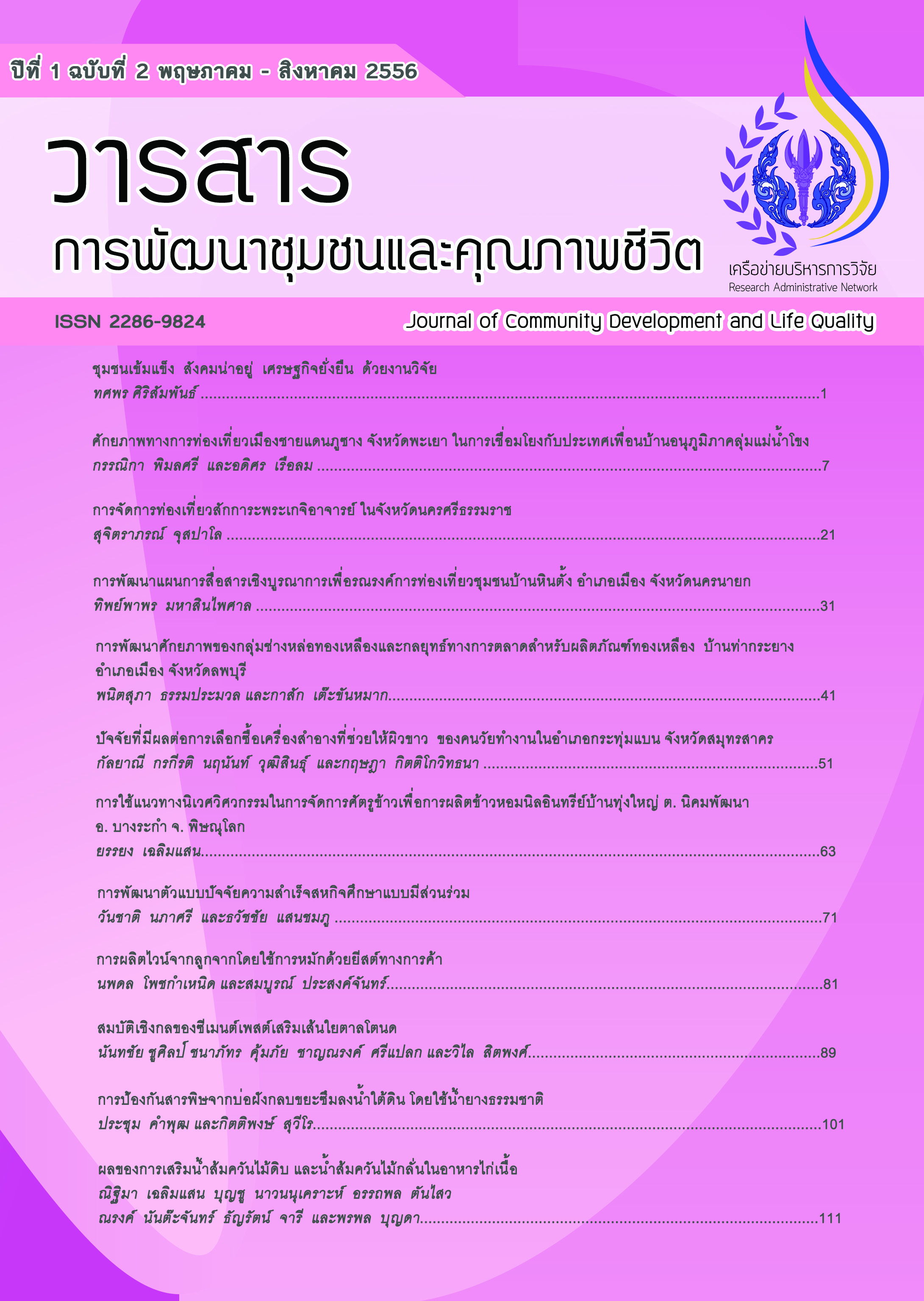การใช้แนวทางนิเวศวิศวกรรมในการจัดการศัตรูข้าวเพื่อการผลิตข้าวหอมนิลอินทรีย์บ้านทุ่งใหญ่ ต. นิคมพัฒนา อ. บางระกำ จ. พิษณุโลก
Main Article Content
บทคัดย่อ
การเรียนรู้นิเวศวิศวกรรมในนาข้าวเพื่อการผลิตข้าวหอมนิลอินทรีย์ของเกษตรกรบ้านทุ่งใหญ่ ตำบลนิคมพัฒนา อำเภอบางระกำ จังหวัดพิษณุโลก เป็นการวิจัยเชิงปฏิบัติการ โดยเปรียบเทียบวิธีการเขตกรรม 2 รูปแบบ คือ วิธีการนิเวศวิศวกรรมในนาข้าวกับวิธีการเขตกรรมแบบดั้งเดิมร่วมกับการใช้สารเคมี วางแผนการทดลองแบบ one, multi-site experiment with single replication มีเกษตรกรผู้ร่วมวิจัยร่วมกิจกรรมตลอดระยะการปลูกข้าว18 คน ผลการศึกษาแสดงให้เห็นว่า แปลงข้าวที่ใช้นิเวศวิศวกรรมในนาข้าวมีค่าดัชนีความหลากหลายทางชีวภาพของแมลงและผลผลิตสูงกว่าแปลงที่ใช้วิธีการเขตกรรมแบบดั้งเดิม สรุปได้ว่านิเวศวิศวกรรมในนาข้าวสามารถเป็นทางเลือกให้เกษตรกรนำไปใช้เพื่อการผลิตข้าวอินทรีย์ได้อย่างมีประสิทธิภาพ
Article Details
กองบรรณาธิการขอสงวนสิทธิ์ในการตรวจและแก้ไขบทความที่เสนอเพื่อตีพิมพ์ในวารสารการพัฒนาชุมชนและคุณภาพชีวิต
บทความหรือข้อความคิดเห็นใด ๆ ที่ปรากฏในวารสารการพัฒนาชุมชนและคุณภาพชีวิต เป็นวรรณกรรมของผู้เขียนโดยเฉพาะคณะผู้จัดทำไม่จำเป็นต้องเห็นด้วย และไม่ใช่ความรับผิดชอบของมหาวิทยาลัยและคณะผู้จัดทำ / บรรณาธิการ
เอกสารอ้างอิง
ยรรยง เฉลิมแสน ณิฐิมา เฉลิมแสน พัชราภรณ์ บัวเปรม และสุขุมวัฒณ์ พีระพันธุ์. 2552. ผลของน้ำส้มควันไม้ในทางชีววิทยาของเพลี้ยกระโดดสีน้ำตาล (Nilaparvata lugens). รายงานผลการวิจัย. มหาวิทยาลัยเทคโนโลยีราชมงคลล้านนา, พิษณุโลก.
โศจิลักษณ์ กมลศักดาวิกุล. 2556. การพัฒนาการจัดการท่องเที่ยวเชิงเกษตรทฤษฎีใหม่โดยชุมชน อำเภอเสาไห้ จังหวัดสระบุรี. วารสารการพัฒนาชุมชนและคุณภาพชีวิต 1(1): 53-65.
สมคิด โพธิ์พันธุ์ และสุพจน์ ชัยวิมล. 2552. การผลิตข้าวอินทรีย์. (ระบบออนไลน์). แหล่งข้อมูล: http:// www.doae.go.th/OA/Data/Kin/01.htm (26 กันยายน 2552).
Abou-Awad, B.A., A.A. El-Sherif, M.F. Hassan and M.M. Abou-Elella. 1998. Studies on development, longevity, fecundity and predation of Amblyseius olivi Nasr & Abou-Awad (Acari: Phytoseiidae) on various kinds of prey and diets. Zeitschrift fur Pflanzenkrankheiten und Pflanzenschutz 105(5): 538-544.
Baggen, L.R. and G.M. Gurr. 1998. The influence of food on Copidosoma koehleri (Hymenoptera: Encyrtidae), and the use of flowering plants as a habitat management tool to enhance biological control of potato moth, Phthorimaea operculella (Lepidoptera: Gelechiidae). Biological Control 11(1): 9-17.
Cardarelli, E. 2011. Influence of rice farming practices on biodiversity: case studies in northern Italy. Scientifica Acta 5(1): 20-26.
Collier, R.H., S. Finch and G. Davies. 2001. Pest insect control in organically-produced crops of field vegetables. Meded Rijksuniv Gent Fak Landbouwkd Toegep Biol. Wet. 66(2a): 259-267.
Deb, D. 2009. Biodiversity and Complexity of Rice Farm Ecosystems: An Empirical Assessment. The Open Ecology Journal 2: 112-129.
Dinham, B. 2003. Growing vegetables in developing countries for local urban populations and export markets: problems confronting small-scale producers. Pest Manag, Sci. 59(5): 575-582.
Escalada, M. 2010. Communication strategy planning and message design workshop. Workshop Report. IRRI-ADB Planthopper Project. Schenhau, Hotel, Jinhua Zheiang, China, 18-20 May 2010.
Gurr, G. 2008. Prospects for ecological engineering against rice pests ricehoppers. (online). Available: http://ricehoppers.net.2008/12_ prospect for ecological engineering against rice pest (Oct. 10, 2007).
Gurr, G.M., S.D. Wratten and M.A. Altieri. 2004. Ecological engineering: a new direction for agricultural pest Management. AFBM Journal. 1(1): 28-35.
Halaji, J., A.B. Cady and G.W. Uetz. 2000. Modular habitat refugia enhance generalist predators and lower plant damage in soybeans. Environmental Entomology 29: 383-393.
Heong, K.L., A. Manza, J. Catindig, S. Villareal and T. Jacobson. 2007. Change in pesticides use and arthropod biodiversity in the IRRI research farm. Outlooks on Pest Management 2229-2233.
Heong, K.L. 2008. Biodiversity, ecosystem services and pest management. Second International Plantation Industry Conference and Exhibition (IPiCEX 2008). Shah Alam 18-21 November, 2008.
Hickman J.M. and S.D. Wratten. 1996. Use of Phacelia tanacetifolia strips to enhance biological control of aphids by hoverfly larvae in cereal fields. Journal of Economic Entomology 89: 832-840.
Jorgensen, S.E. and S.N. Nielsen. 1996. Application of ecological engineering principles in agriculture. Ecological Engineering. 7: 373-381.
Long, R.F., A. Corbett, C. Lamb, C. Reberg-Horton, J. Chandler and M. Stimmann. 1998. Beneficial insects move from flowering plants to nearby crops. California Agriculture 52(5): 23-26.
McKone, M.J. and C.M. Lively. 1993. Statistical analysis of experiments conducted at multiple sites. Oikos. 67: 184-186.
Mitsch, W.J. and S.E. Jørgensen. 1989. Ecological Engineering. An Introduction of Ecotechnology. John Wiley and Sons. New York.
Pretty, J. 2008. Agricultural sustainability: concepts, principles and evidence. Philos. Trans. R. Soc. Lond. B Biol. Sci. 363(1491): 447-465.
Ricehoppers. 2010. Sampling protocols for studying ecological engineering for rice pest suppression in irrigated tropical rice. (online). Available: http://ricehoppers.net/wpcontent/uploads/2010/03/revised-sampling-protocol-21Dec1.pdf (July. 3, 2010).
Saad, A., H. Yahaya, H. Muhammad, M. Azmi, W.M. Wan Zaki, A. Manim, A. Badrulhadza, M. Siti Norsuha, M.S., Maisarah, M.Y. Noridiana, A.R. Muhammad Naim Fadzli and A. Sivapragasam. 2010. Malaysia using ecological engineering in rice estates to manage pests. (Online). Available: http://ricehoppers.net/2010/07/malaysia-using-ecological-engineering-in-rice-estates-to-manage-pests/ (Oct. 10, 2006).
Shannon, C.E. and W. Weaver. 1949. The Mathematical Theory of Communication. Illinois Press, University of Urbana.
Sutherland, J.P., M.S. Sullivan and G.M. Poppy. 2001. Distribution and abundance of aphidophagous hoverflies (Diptera: Syrphidae) in wildflower patches and field margin habitats. Agricultural and Forest Entomology 3: 57-64.
Viggiani, G. 2003. Functional biodiversity for the vineyard agroecosystem: aspects of the farm and landscape management in southern Italy. Bulletin OILB/SROP. 26(4): 197-202.


